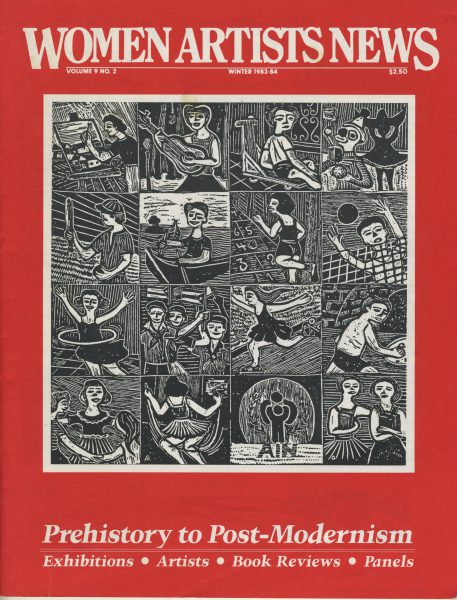
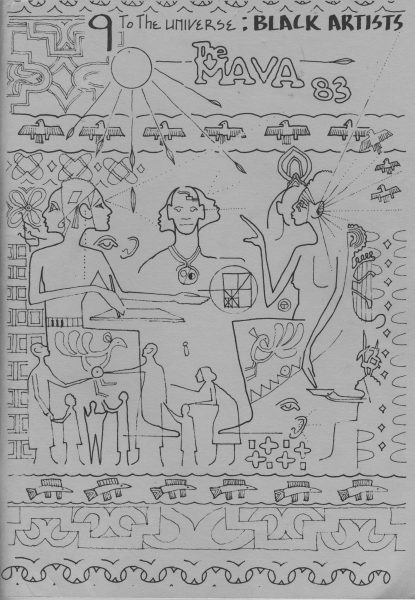
Viewing the textural paintings of Howardena Pindell and the soft sculptures of Faith Ringgold is like rediscovering traditional “crafts” in the works of contemporary artists. While their methods and their materials are significantly different, these artists are grappling with similar issues. Absorbed in their work in a way we have come to associate only with “serious male artists,” these women see their “art as a way of life” (Faith Ringgold). Whether or not they rely on the sale of their work to support themselves, they are both “successes” in their own right and are willing to talk about their feelings on being Black female artists.
Howardena Pindell
Howardena Pindell agreed to meet me on a Saturday morning at her studio/house in Greenwich Village. Here in this vast warehouse loft we talked for several hours about her work and her life in the New York art world.
Our discussion started with Pindell’s “middle class” childhood growing up in Philadelphia. While her parents never actually discouraged her artistic interests, their attitude was one of “why bother, she isn’t going to do anything with it anyway,” — not an uncommon response for parents of young girls in the 1950’s who wanted to pursue unconventional careers.
As a student at an all girl’s private school, Pindell found the art-department the most liberating in the school. Still, there was one teacher she remembers who was very prejudiced against her: “She would literally hide my work.”
Pindell completed her undergraduate degree at Boston University in 1964 and then went on to Yale University to work on her Masters in Fine Arts. While the Art department at Yale had a reputation for progressive attitudes towards art in general, this liberal attitude did not extend to art that used traditional female methods and materials. The academic training addressed an “old, turn-of-the-century style” of painting. Students were discouraged from looking elsewhere for sources. In short, she claims, “I was free to do whatever they [the professors] wanted.” During the class critiques, the men belittled much of the women’s· work: “If a woman used red and white together, they would refer to it as pink. If a man used these colors, they called it ‘red and white.’” Collage, considered part of the female aesthetic tradition, was viewed as a second-rate medium by the predominately male faculty.
Howardena Pindell’s memories of her experiences in Boston and New Haven are similar to the observations made by Virginia Woof in A Room of One’s Own. In her references to Oxbridge University, Woolf endows these bastions of male dominated culture with qualities of “complacency” and perpetual sleep. Figuratively speaking, no woman could ever “wake those echoes.” Both Pindell and Woolf are critical of the stagnating atmosphere found in a traditional academic environment. Having “removed themselves above the strife of tongue, and the confusion of body,” the men in Woolf’s university were busy searching for answers on the shelves of the British museum (1). A woman, she claims, must look beyond the hallowed walls of the college to find her inspiration — in nature and in the home.
In this same spirit, Howardena Pindell combines disparate material in her art … “something they [her male professors] said you weren’t supposed to do.” While she outwardly rejects gender associations, Pindell believes that many women artists have “taken on a textural form as a reaction to the flat work of men.” She herself uses tiny dots of colored paper, sequins, stripped canvas, thread and checks from her personal checkbook. As seen in a catalogue of women’s art exhibits from the 1970’s and 80’s, Pindell is not alone in her use of unusual material and styles rooted in a female tradition. Each component of her work is transformed into personal and historical metaphor. (2) Indeed, she is fascinated by a multi-media approach. Her enormous abstract paintings give the illusion of craters and fissures on the moon.
At first glance, the abstract quality of her early work makes it difficult to approach from a “feminist perspective.” If, however, one views the materials themselves as implicitly female, the message becomes extremely political. Specifically non-male elements such as glitter, thread and personal objects are contained within her paintings. Pindell’s use of materials steeped in the tradition of sewing and crafts represents her own rejection of conventional painting materials.
Reflecting on the abstract quality of her 1970’s work, Pindell expressed her dissatisfaction with its detached quality. “I can’t become a formalist again,” she explains, “I can’t be that cold. My work has started getting this oval shape. The dots disappeared.” The sources for Pindell’s work are “incidents from [her own life.”] She now feels compelled to make it more personal and expressive. Still not liberal in its imagery, her art has started to integrate real objects from her own life experiences. A recent show entitled “Memory Series” used cut up postcards as references to a particularly difficult period in her life. While the final pieces take on an abstract quality, there is still an emotional vitality that is not present in her earlier work. The vibrant colors themselves express the artist’s involvement with the materials.
Pindell’s fascination for “once-used” objects challenges “the history of white western art where there is an obsession with the purity of materials.” (3) Only by searching in the least predictable locations (her checkbook, for example) does she feel that she can find objects which suit her eclectic canvases. She believes that the artist herself must make her own personal choices concerning the selection and use of materials.
Although she is reluctant to talk about a specific female imagery in her art, Pindell’s attitude toward traditional women’s art has changed dramatically over the last few years:
I always saw crafts as vey separate. I guess I had a very
male-oriented view within the past five years, after leaving
the museum (of Modern Art) where I always categorized,
my perception has changed. Now I go to the “non-fine arts,”
especially textiles. It has to be sincerely grassroot, not
infected by Vogue magazine.
She remembers her experience at a crafts fair she attended in Vermont where she saw “incredible Bibles made out of bread — and prize winning pies.” According to Pindell, this moment was crucial to the development of her own art aesthetic. Struck by the originality of the women’s work she saw there, she gained a new respect for the crafts movement. Her description of the artistic process involved in her work indicates a new interest in traditional female methods:
I took some thread… I was making my own clothes then,
since I couldn’t afford to buy any … And I made a sewn
grid with strips which I interwove… like a basket. (4)
But Pindell’s breadth of artistic materials also includes a more modern medium — video. In her film “Free, White, and Twenty-One”, she takes an extremely political stand:
I put myself in white face. I did it on purpose because I
was really very angry about what was going on in the
women’s movement… because I saw it as very white…
I did this piece as a kind of revenge.
In this video Pindell explores the image of Blacks in advertising. She dresses up in white face and performs. As a black woman in white American, she feels hostile towards both the women’s movement and the country as a whole.
Whether or not one looks at Howardena Pindell’s paintings or her film, her materials are often inherently political. Because her paintings are abstract, for the most part, their “subjects” are not necessarily related to being either Black or Female. Her film, on the other hand, addresses both issues with an acute vehemence and is central to her feelings about racism and sexism. Conscious of historical traditions, she refuses to put her art into categories based on style or materials. Pindell knows that her work might never attract abundant critical acclaim within the New York art world, specifically because of her racial and sexual identity. In the closed white, male institutions of galleries and museums, there is little room for a Black woman.
My interview with Faith Ringgold begain in the early morning, this time Uptown on 128th Street in Harlem. Although she has lived in this neighborhood all of her life, most of her neighbors still wonder “why the hell she wants to be an artist.” An energetic woman wearing a full length African robe, Ringgold says she strives on living the life of an artist. Her crowded 14th floor apartment, an extravaganza of colorful fabrics and canvases bears witness to her creativity. Dolls, masks, psychedelic abstract paintings and tapestries burst from every corner of the house.

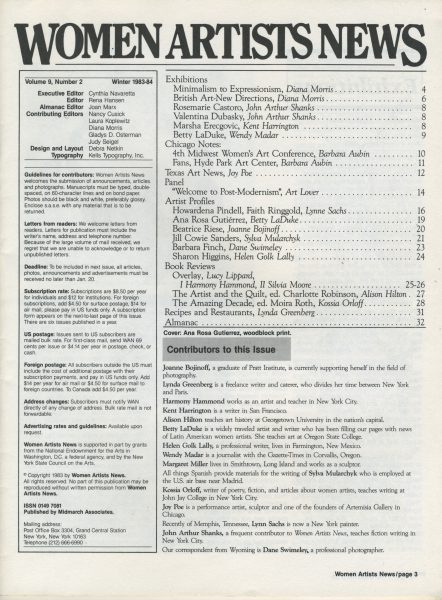
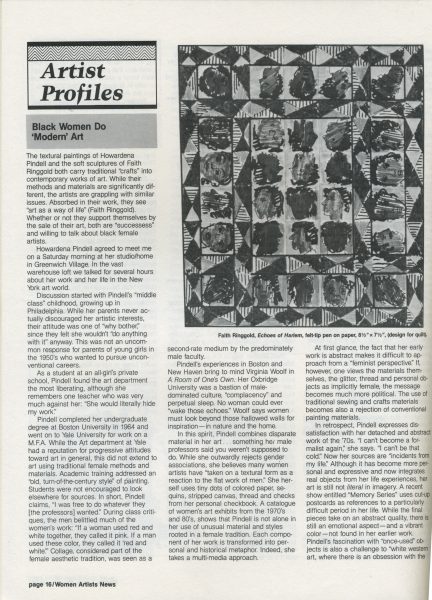
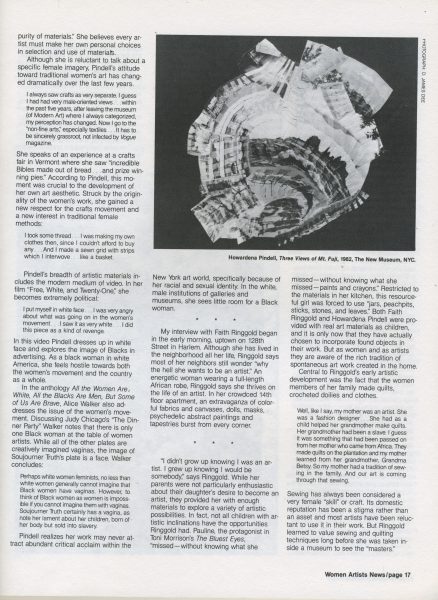
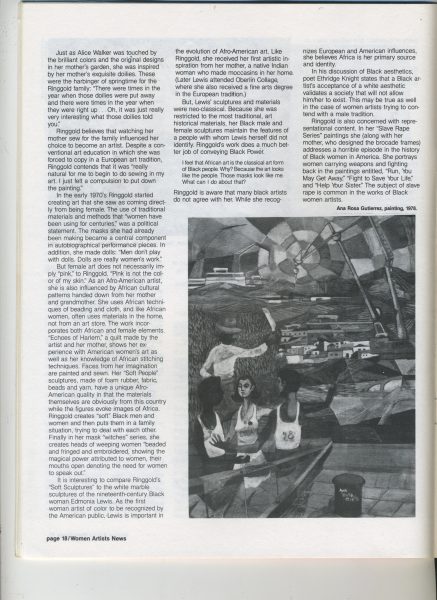
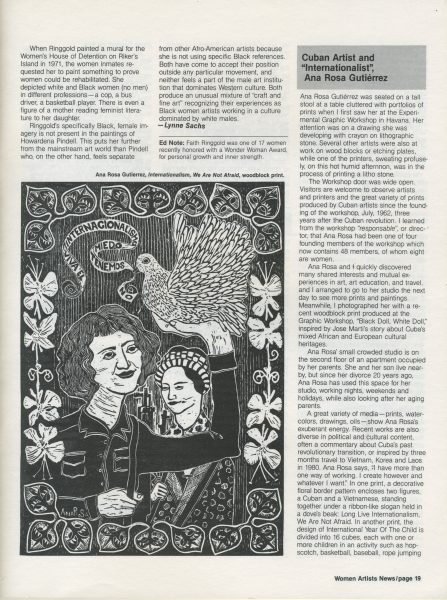
Faith Ringgold
“I didn’t grow up knowing I was an artist. I grew up knowing I would be somebody,” says Ringgold. While her parents were not particularly enthusiastic about their daughter’s desire to become an artist, they provided her with enough materials to explore a variety of artistic possibilities. Unfortunately, not all children with similar artistic inclinations are given the same opportunities that Ringgold had. Pauline, the protagonist in Toni Morrison’s The Bluest Eyes, “missed—without knowing what she missed — paints and crayons.” (7) Restricted to the materials found in her kitchen, this resourceful girl was forced to use “jars, peachpits, sticks, stones, and leaves” as her materials. Both Faith Ringgold and Howardena Pindell were provided with art materials as children, and it is only now that they have actually chosen to incorporate found objects from their personal lives in their work. As women and as artists they are aware of the rich tradition that comes from the spontaneous art work created in the home.
Central to Ringgold’s early artistic development was the fact that she lived in a home where the women members of the family stitched quilts, crocheted doilies and made clothes.
Well, like I say, my mother was an artist. She was a fashion
designer … She had as a child helped her grandmother
make quilts. Her grandmother had been a slave. I guess it was
something that had been passed on from her mother who
came from Africa. They made quilts on the plantation and
my mother learned from her grandmother, Grandma Betsy.
So my mother had a tradition of sewing in the family.
And our art is coming through that sewing.
Sewing has always been considered a very female specific “skill.” Viewed primarily as a craft, its domestic reputation has become a stigma rather than an asset and most artists are reluctant to use it in their work. Not so with Ringgold or Pindell. Both have drawn their deep-rooted appreciation for traditional women’s art into their own work. As Ringgold explains, she learned to value sewing and quilting techniques long before she was taken inside a museum to see the “masters.”
Just as Alice Walker w.as touched by brilliant colors and the original designs she saw in her mother’s garden (8), Faith Ringgold was inspired by her mother’s exquisite doilies. These doilies were the harbinger of springtime for the Ringgold family: “There were times in the year when those doilies were put away and there were times in the year when they were right up … Oh, it was just really very interesting what those doilies told you.” As cherished decorations on the sofa and the chairs, these doilies were the primary ingredient in a unique family ritual directed by her mother, — spring and winter cleaning. For this reason, Faith Ringgold never took their presence for granted and considered them sacred objects in her home.
Ringgold believes that these early childhood experiences watching her mother sew for the family influenced her choice to pursue art as a career. Her notions of artistic creativity were modeled after women artists that she knew. Despite a conventional art education in which she was forced to copy in a European art tradition, Ringgold contends that it was “really natural for me to begin to do sewing in my art. I just felt a compulsion to put down the painting.”
In the early 1970’s, Ringgold started creating art that she claimed came directly out of being a woman. Her use of materials and traditional methods of making art that “women have been using for centuries,” was part of her political statement. The masks she had already been making now became a central component to her autobiographical performance pieces. In addition, she made dolls: “Men don’t play with dolls. Dolls are really women’s work.” Consequently, she cannot ignore their presence in her life.
But female art does not necessarily imply “pink,” says Ringgold, “Pink is not the color of my skin.” As an Afro-American artist, Ringgold is also influenced by African cultural patterns that were handed down by her mother and her grandmother. Ringgold explains that she uses African techniques of beading and cloth in order to create “a female imagery out of the materials.” Like African women, she often uses materials she can find, that are accessible in the home and not only in an art store. As mentioned in the “Transformation catalogue on Women’s Art,’ these techniques “traditionally associated with women’s work [are] transformed into personal and historical metaphor.”(10) Faith Ringgold incorporates both an African and a female element in her work. “Echoes of Harlem,” a quilt made by the artist and her mother, takes advantage of Ringgold’s experience with American women’s art as well as her knowledge of African stitching techniques. Within the quilt, faces from Ringgold’s imagination are painted and sewn. Her “Soft People” sculptures, made of foam rubber, fabric, beads and yarn, have a unique Afro-American quality in that the materials themselves are obviously from this country while the figures evoke images of Africa. Ringgold creates “soft” black men and women and then puts them in a family situation as they are trying to deal with each other. Finally in her mask “witches” series, she creates heads of weeping women “beaded and fringed and embroidered on fabric, showing the magical power attributed to women, their mouths open denoting the need for women to speak out.”(11) Ringgold’s choice to work within these traditions makes both a political and personal statement, as do the specific elements contained with the work. (12)
It is interesting to compare Ringgold’s “Soft Sculptures” to the white marble sculptures of the nineteenth-century artist Edmonia Lewis. As. the first woman of color whose work as an artist was recognized by the American public, Lewis has an important position in the evolution of Afro-American art. Like Ringgold, she received her first artistic inspiration from her mother, a native Indian woman who made moccasins in her home. Later, Lewis attended Oberlin College where she also received a fine arts degree.
In contrast to Ringgold’s dark, pliable figures made of fabrics and beads. Lewis’ sculptures used the style and the materials of the nee-classical style. But hers was a method of imitation that only partially succeeded in depicting the experiences of Black people. Because Lewis was restricted to the most traditional, art historical materials, her Black male and female sculptures maintain the features of a people with whom Lewis herself did not identify. In this way, the stone itself weakened Lewis’ theme of black liberation from the bondage of slavery. (13) Ringgold’s work does a much better job of conveying a sense of Black power.
Ringgold, like Lewis, is committed to African art. Her love for the work comes from her identification with the human figures found in the images.
I feel that African art is the classical art form of black
people. Why? Because the art looks like the people …
Those masks look like me. What can I do about that?
Ringgold is aware that many black artists do not agree with her. While she recognizes that European and American art influence in her work, she believes that Africa is her primary source and that a denial of this heritage would be a denial of her own identify.
In his discussion of black aesthetics, poet Ethridge Knight states that a black artist’s acceptance of a white aesthetic is equivalent to validating a society that will not allow him/her
to exist. (14) This may be true as well in the case of women artists trying to contend with a male tradition. The issues presented in both situations are similar, and therefore, are especially problematic for the black woman. The dominant culture for her, whether it be male or, white, continues to impose its standards on her own-equally valid aesthetic.
These issues are not, however, limited to questions of formal criticism. Central to an understanding of the problems confronted by a black woman artist such as Faith Ringgold is a concern with the representational content in her work. In her “Slave Rape Series,” of paintings, she ( along with her mother who designed the brocade frames) addresses a horrible episode in the history of black women in America. Ringgold portrays women carrying weapons and fighting back in the paintings entitled “Run, You May Get Away,” “Fight to Save Your Life,” and “Help Your Sister.”
The subject of slave rape is common in the works of black women artists. In her book, Ain’t I a Woman: Black Women and Feminism: Bell Hooks talks about the significance of the rape of enslaved black women:
It was not simply that it deliberately crushed their sexual
integrity for economic ends but that it led to a devaluation
of black womanhood that permeated the psyches of
all Americans … (15)
Faith Ringgold wants to rectify this perverse situation and her series of paintings illustrates her effort.
Ringgold also expresses her black-feminist consciousness in the form of a mural for the Women’s House of Detention on Riker’s Island (made in 1971). The women inmates requested her to paint something stimulating to prove women could be rehabilitated. Therefore, she decided to depict White and Black women (no men) in different professions–a cop, a bus driver, a basketbarl player. There is even a figure of a mother reading feminist literature to her daughter. (16)
Faith Ringgold uses a Black, female imagery in her work that is not present in the paintings of Howardena Pindell. In many ways, she has estranged herself from the mainstream art world to a greater degree because of this explicitly personal quality in her work. Pindell, on the other hand, feels separate from other Afro-American artists because she is not using specific Black references in her work. Both women have come to accept their position on the outside of any particular movement, and neither feels a part of the traditional art institutions that dominant Western culture.
It is interesting to note that both women are also involved in using traditional female art. By integrating these domestic techniques into their work, these artists produce an unusual mixture of “craft and fine art.” No longer does the distinction between the two categories apply to Pindell’s canvases or Ringgold’s masks, for our standard system of labeling does not explain their work.
Issues involving the black woman artist become particularly compelling to those of us interested in studying the phenomena of racism and sexism in American society. While there is a certain validity to objective, formal criticism, it is important to go beyond these aesthetic limitations. We can only come to terms with the subject matter of art such as Ringgold’s or Pindell’s (specifically her video) by recognizing their particular experiences as black women artists working within a culture dominated hr white males.
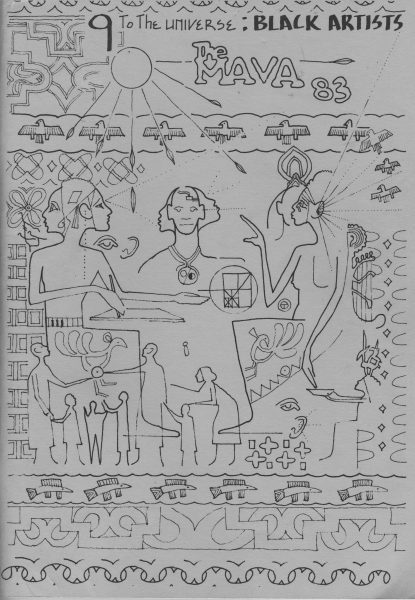
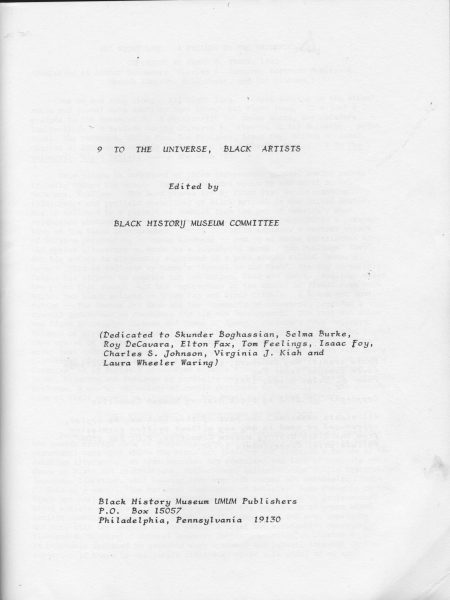
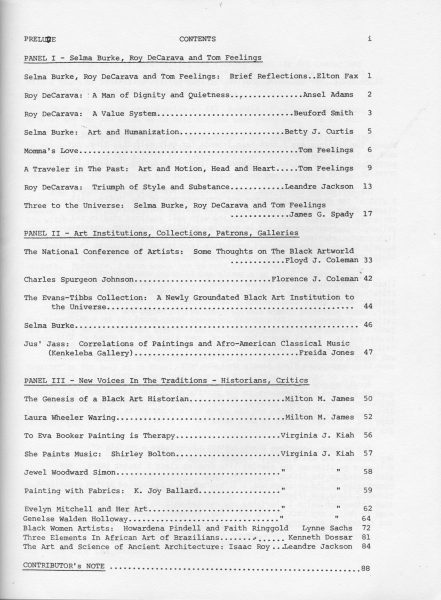
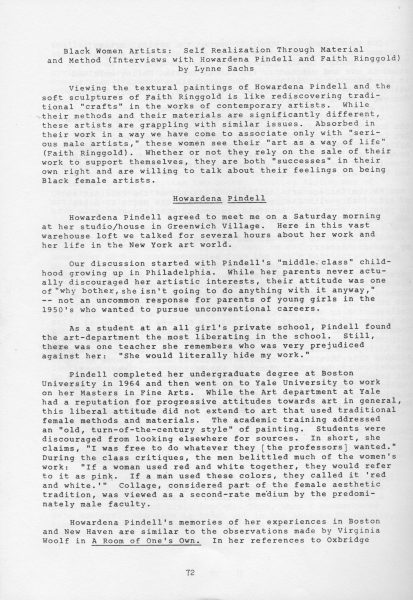
NOTES
1 Virginia Woolf, A Room of One’s Own, (New York: Harcourt Brace, Jovanocivh, 1957), p. 25.
2 “Transformations: Women in Art of the 70’s and 80’s, New York Coliseum, March 5-9, 1981” Curated by Catherine Allen, New York Feminist Art Institute, p. 2.
3 Michelle Cliff, “Object into Subject: Some Thoughts on the Work of Black Women Artists, in Heresies: A Feminist Publication on Art and Politics, Vol. 4, No. 3, Issue 15, 1982, p. 38.
4 Lynn F. Miller and Sally s. Swenson, Lives and Works: Talks with Women Artists, (Metchen, N.J.: The Scarecrown Press, Inc., 1981), pp 143-44.
5 Bell Hooks, Ain’t I A Woman: Black Women and Feminism, ( Boston: South End Press, 1981), p. 161.
6 Toni Morrison, The Bluest Eye, (New York: Washington Square Press, 1970), p. 89.
7 Alice Walker, “In Search of Our Mother’s Garden” in Southern Exposure, Vol. IV, No. 4, p. 64.
8 Woolf, p. 79.
9 “Transformations” , p. 2.
10 Lucy Lippard, From the Center, (New York: E.P. Dutton & Company, 1976), p. 260
11 “Transformations”, p. 3
12 Cliff in Heresies, p. 37.
13 Elsa Honig Fine, The Afro American Artist, (New York: Holt Rinehart and Winston, 1973), p.
